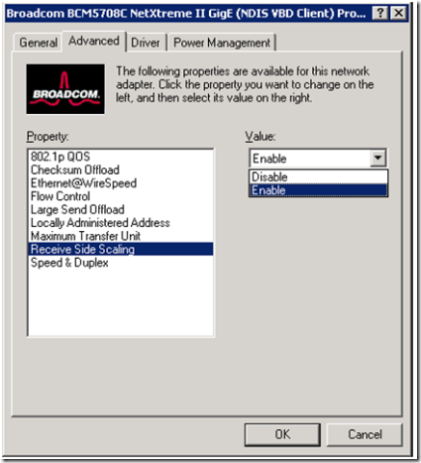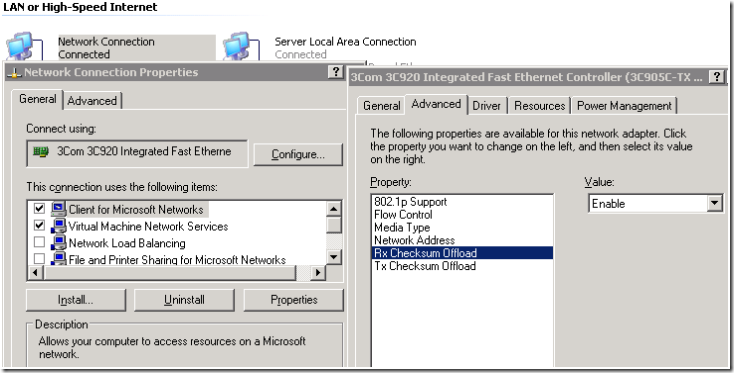Common Networking Issues After Applying Windows Server 2003 SP2 on SBS
[Today's post comes to us courtesy of Mark Stanfill]
Overview
We have seen an increasing number of support calls from customers experiencing a variety of networking-related issues after installing Windows Server 2003 SP2. We have previously covered this topic in this blog (here), and we wanted to come back to the topic now that we have a better idea of the scope of the issue, what causes it, and a better idea of how to fix these issues. The issues discussed here are not unique to SBS, but they do tend to be more common in SBS networks because of the large number of SBS 2003 servers used for NAT (either RRAS or ISA). There are a smaller number of issues that can appear even in single-NIC scenarios. In most of the cases we've seen, updating the NIC drivers fixes the issue, but there are a significant portion of these cases where RSS and TCP Chimney Offload (TaskOffload) need to be disabled via the registry as well.
Background
Windows Server 2003 SP2 introduces a number of new networking features, including TCP Chimney Offload, Receive Side Scaling (RSS), and Network Direct Memory Access (NetDMA). Unfortunately, RSS and TCP Chimney Offload are not compatible with these technologies:
• Windows Firewall
• Internet Protocol security (IPsec)
• Internet Protocol Network Address Translation (IPNAT)
• Third-party firewalls
• NDIS 5.1 intermediate drivers
We are researching a solution and expect to have an update available soon.
Symptoms and Issues We've Seen
I have to be careful here - this is a list of symptoms that we've seen where the troubleshooting tips below resolved the issue, but there are a number of caveats here. First, not all of these have been verified. For each of these symptoms, there are a huge number of other potential causes. The steps in the troubleshooting section below should only be used in cases where you are seeing one of the symptoms below and the only thing that has changed is that you've recently installed SP2.
- Unable to VPN to the Server ("Error 800: Unable to establish connection").
- Unable to RDP to SBS server
- Unable to connect to shares on SBS server from the LAN
- Unable to join a client machine to the domain
- Unable to connect to Exchange from Outlook
- Unable to connect to SSL sites either on the SBS server or on the Internet (including CompanyWeb)
- Slow network performance
- Outgoing FTP connections fail
- DHCP Server service crashes
- Slow domain logins
- Intermittent connection failures from NAT clients behind the server
- Intermittent RPC communications failures
Troubleshooting
The critical question in determining which steps to use is "how many NICs are in the box?". If you have a multi-homed box (more than 1 NIC), use all four steps below. If you have a single NIC SBS server, our recommendation is to follow the steps below in order and see if each step provides resolution. RSS can provide significant performance enhancements if your network hardware supports it end-to-end. Our general recommendation is to update your NIC driver in 100% of cases.
Step 1: Update the Driver
Most of the issues we've seen are related to older NIC drivers that do not know how to use the advanced networking features ( of Windows Server 2003 SP2. Virtually every major manufacturer has come out with a new driver in '07. Before you do anything else, make sure that you have the latest Server 2003 drivers for you NIC. The vast majority of the cases we've seen can be solved by this step alone.
Step 2: Disable Offloading on the Advanced Properties of the NIC
Most NICs have various offloading functions that can increase network performance (or at least lower CPU usage on the server). Again, this is only if your network hardware supports high throughput end-to-end. That means that your NICs, cabling, switches, and possibly routers all have to support gigabit networking and know how to deal with these offloading functions. Your vendor(s) have the final say on wether RSS, checksum offloading, etc. will work with the combination of equipment you have. That's a nice way of saying that your typical "lean and mean" small business is not likely to have invested in high-end hardware. In support, we routinely turn these functions off when troubleshooting any networking issues. We've never seen a case in an SBS environment where there was perceived network slowness after disabling offload functions. If in doubt, disable all advanced features, test to see if they provide relief, and then re-enable them one by one to see if A) these features cause your networking issue and B) if they offer any kind of performance gain. Here are a few examples (your vendor will likely have different settings based on model and driver revision)
Step 3: Disable RSS in the Registry
Use the steps in KB 927695 to disable Receive Side Scaling (RSS) by adding a DWORD registry key value for
HKEY_LOCAL_MACHINE\SYSTEM\CurrentControlSet\Services\Tcpip\Parameters\EnableRSS and setting it to 0. A reboot is required to make the value go in to effect.
(Like the KB article says, usual caveats about having a backup, etc apply before making any registry changes).
Step 4: Set DisableTaskOffload in the Registry
Use the steps in KB 904946 to create a DWORD value for
HKEY_LOCAL_MACHINE\SYSTEM\CurrentControlSet\Services\Tcpip\Parameters\DisableTaskOffload and set it to 1. A reboot is required to make this value go in to effect.
Comments
Anonymous
January 01, 2003
Common Networking Issues After Applying Windows Server 2003 SP2 on SBS ...Anonymous
January 01, 2003
http://blogs.technet.com/sbs/archive/2007/04/24/common-networking-issues-after-applying-windows-serverAnonymous
January 01, 2003
Last week we've migrated content from one farm to another using stsadm –o export / import. The exportAnonymous
January 01, 2003
The Official SBS Blog : Common Networking Issues After Applying Windows Server 2003 SP2 on SBS: httpAnonymous
January 01, 2003
Ok so I am going to try and make this as simple as possible. SBS SP1 is not the same as Windows ServerAnonymous
January 01, 2003
Thanks to Mark Stanfill for this excellent post on SP2 issues with SBS. It should be noted that a lotAnonymous
January 01, 2003
Longhorn Beta3 recenze Jak je dobrým zvykem na SuperSite recence na Longhorn na sebe nedala dlouho čekat a je poměrně hodně obsáhlá. Doporučuji k přečtení Paul Thurrott's SuperSite for Windows- Wind ...Anonymous
January 01, 2003
From the Official SBS Blog 1) “Critical Update for Windows Small Business Server 2003: Vista andAnonymous
January 01, 2003
I'm trying to break a server and I'm not having any luck tonight.... how am I trying to breakAnonymous
January 01, 2003
http://blogs.technet.com/sbs/archive/2007/04/24/common-networking-issues-after-applying-windows-serverAnonymous
January 01, 2003
[Today's post comes to us courtesy of Mark Stanfill] Windows Server 2003 SP2 will be released to AutomaticAnonymous
January 01, 2003
[Today's post comes to us courtesy of Duncan Chalmers and Damian Leibaschoff] Today the SBS SE team releasedAnonymous
January 01, 2003
The Microsoft SBS Blog released a post last week with some excellent information about a known problem with networking that occurs after the installation of SP2 onto Small Business Server. A series of resolutions is also posted. Some of the network problemsAnonymous
January 01, 2003
The Official SBS Blog : New SBS 2003 Updates released through Microsoft Update and WSUS: http://blogsAnonymous
January 01, 2003
Today, I have been remotely connected to a server. This server just stopped functioning after WindowsAnonymous
January 01, 2003
PingBack from http://blogs.technet.com/sbs/archive/2007/03/19/vpn-securenat-nat-and-outlook-clients-not-working-after-installing-windows-service-pack-2-in-sbs-2003-premium.aspxAnonymous
January 01, 2003
So tonight I was taking some vmwares of SBS's and I had already played a bit with Acronis and Paragon'sAnonymous
January 01, 2003
If the readme for SP2 was written like it should be it would be like this: Before you install BeforeAnonymous
November 10, 2014
Hello Sir, i have network where some systems are connected to server 2003 trough a switch. the problem is few system unable to ping or connected sometimes when i trying to disable and again enable NIC of server then the problem is solve. plz tell me what is the problemAnonymous
October 21, 2015
I'm trying to resurrect a Windows 2003 Small Business Server and when I use the Add New User Wizard, it faisl with errors saying "the Home Folder could not be created" and "Quota information could not be set". This was working the first time i set up a new users but now does not. I am using the User Profile.
Any ideas??



